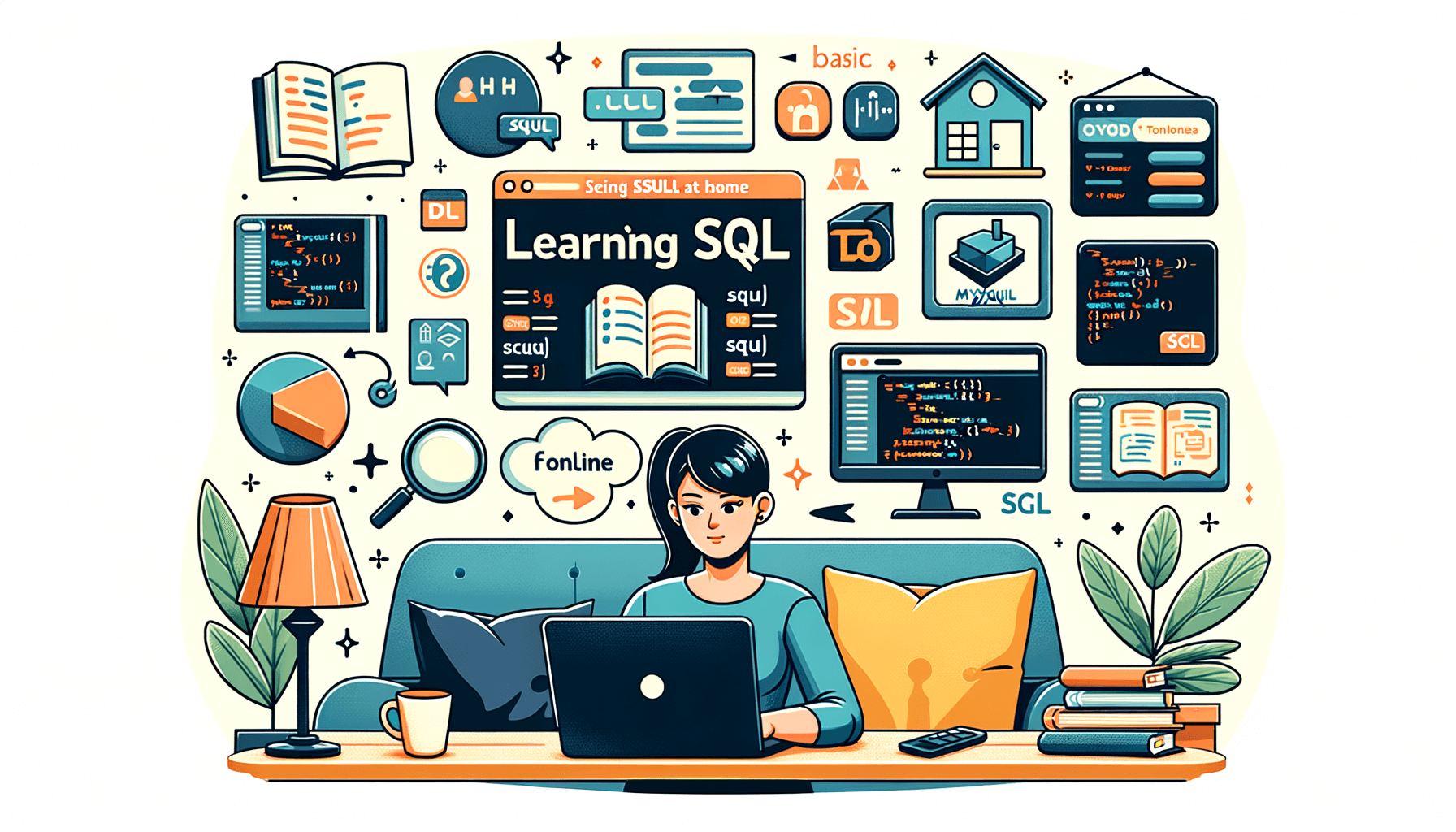A big variety of articles and resources

What are some tips and tricks to learn SQL quickly at home?
 Sia Author and Instructor
Learn SQL
Sia Author and Instructor
Learn SQL
13 minute read
Learning SQL at home can be a fun and rewarding experience. SQL, or Structured Query Language, is used to manage and manipulate databases. Whether you are a beginner or looking to improve your skills, there are many tips and tricks to help you learn SQL quickly and effectively from the comfort of your own home.
Key Takeaways
- Start with the basics of SQL to build a strong foundation.
- Choose the right database to practice and make learning easier.
- Use online resources and tutorials for guided learning.
- Practice with real-world data to understand practical applications.
- Join SQL communities to get help and share your progress.
Understanding the Basics of SQL
Defining SQL and Its Importance
SQL, or Structured Query Language, is a standard language used to communicate with databases. It's essential for managing and manipulating data. Knowing SQL allows us to retrieve, update, and delete data efficiently. This skill is crucial for anyone working with data, from analysts to developers.
Common SQL Commands
To get started with SQL, we need to learn some basic commands:
- SELECT: Retrieves data from a database
- INSERT: Adds new data to a database
- UPDATE: Modifies existing data
- DELETE: Removes data from a database
These commands form the foundation of SQL and are used in almost every query.
Setting Up Your SQL Environment
Before we can start writing SQL queries, we need to set up our environment. This involves:
- Choosing a database management system (DBMS) like MySQL, PostgreSQL, or SQLite.
- Installing the DBMS on our computer.
- Setting up a database and tables to practice on.
Setting up the environment correctly is crucial for a smooth learning experience. It ensures we can practice and experiment without any issues.
Choosing the Right SQL Database
Comparing Popular SQL Databases
When starting with SQL, it's important to choose the right database. There are many options, each with its own strengths. Popular choices include MySQL, PostgreSQL, and SQLite. MySQL is widely used in web applications, PostgreSQL is known for its advanced features, and SQLite is great for small projects and learning.
Selecting a Database for Practice
For beginners, we recommend starting with SQLite or MySQL. These databases are easy to set up and use. SQLite is perfect for learning because it doesn't require a server. MySQL, on the other hand, is great for understanding how databases work in real-world applications.
Installing and Configuring Your Database
To get started, you'll need to install your chosen database. For SQLite, you can download the software and start using it right away. For MySQL, you'll need to go through an installation process. Follow the instructions on the official website to set it up. Once installed, you can start creating databases and tables to practice your SQL skills.
Remember, choosing the right database is crucial for your learning journey. Take your time to explore different options and find the one that suits your needs best.
Learning SQL Syntax and Structure
Basic SQL Syntax
To start with SQL, we need to understand its basic syntax. SQL, or Structured Query Language, is used to communicate with databases. It's essential to grasp the basic commands like SELECT, INSERT, UPDATE, and DELETE. These commands form the foundation of SQL and are used to perform various operations on the data stored in a database.
Understanding SQL Queries
SQL queries are the instructions we give to the database to retrieve or manipulate data. A query typically starts with a command, followed by the table name, and then the conditions. For example, a simple SELECT query might look like this:
SELECT * FROM students WHERE grade = 'A';
This query retrieves all records from the students table where the grade is 'A'. Understanding how to structure these queries is crucial for effective database management.
Writing Your First SQL Statement
Writing your first SQL statement can be exciting. Start with a simple SELECT statement to get data from a table. For instance:
SELECT name, age FROM students;
This command fetches the name and age of all students from the students table. As you get comfortable, you can try more complex queries. Remember, practice is key to mastering SQL.
When learning SQL, it's helpful to use platforms like sqlskillz.com vs udemy.com: master sql basics, perfect for beginners, learn at your own pace. no credit card required. login or sign up to start learning. These platforms offer interactive lessons that make learning engaging and effective.
Utilizing Online Resources and Tutorials
When it comes to learning SQL online, we have a variety of resources and tutorials available to us. These resources can help us grasp the concepts and practice our skills in a structured manner. One key resource is interactive platforms that allow us to engage with SQL queries in a hands-on way. Additionally, online courses provide in-depth lessons on SQL syntax and best practices. Exploring SQL documentation can also be beneficial for quick reference and understanding. By utilizing these online resources effectively, we can enhance our SQL learning experience and build a strong foundation for further exploration and practice.
Practicing with Real-World Datasets
Locating Open Data Sources
To get better at SQL, we need to work with real-world data. There are many places online where we can find open data sources. Websites like sqlskillz.com vs. datacamp.com offer datasets that are perfect for beginners. These platforms let us master SQL basics at our own pace, and we don't even need a credit card to sign up.
Importing Data into Your SQL Database
Once we have our dataset, the next step is to import it into our SQL database. This process usually involves a few steps:
- Download the dataset in a compatible format, like CSV.
- Use SQL commands to create a table that matches the dataset's structure.
- Import the data into the table using the appropriate SQL command.
Creating Practice Queries
With the data in our database, we can start writing practice queries. This is where we can apply what we've learned and see real results. Writing queries on real data helps us understand SQL better and prepares us for real-world tasks. We can start with simple queries and gradually move to more complex ones.
Practicing with real-world datasets is a great way to improve our SQL skills. It gives us a chance to work with data that we might encounter in real jobs, making our learning experience more practical and relevant.
Joining SQL Communities and Forums
Participating in SQL Discussions
Engaging in SQL discussions can greatly enhance our learning experience. By joining forums and communities, we can ask questions, share knowledge, and get feedback from others. This interaction helps us understand different perspectives and solutions to SQL problems.
Seeking Help from Experts
When we encounter challenging SQL issues, seeking help from experts can be invaluable. Many experienced SQL professionals are active in online communities and are willing to offer their insights. Their guidance can help us overcome obstacles and improve our skills.
Sharing Your SQL Projects
Sharing our SQL projects with the community not only showcases our skills but also invites constructive criticism. This feedback can be crucial for our growth and learning. Additionally, it allows us to contribute to the community by providing examples and solutions that others might find useful.
Being part of an SQL community is like having a support system that encourages continuous learning and improvement.
Working on SQL Projects
Designing a Simple Database
When we start working on SQL projects, the first step is to design a simple database. This helps us understand the structure and relationships between different data points. We can begin by identifying the key entities and their attributes. For example, if we are creating a database for a library, our entities might include books, authors, and members. Each entity will have its own set of attributes, such as book titles, author names, and member IDs.
Implementing CRUD Operations
Once our database design is ready, we can move on to implementing CRUD operations. CRUD stands for Create, Read, Update, and Delete. These operations are essential for managing data in our database. We can start by writing SQL statements to insert new records, retrieve existing records, update records, and delete records. Mastering these operations is crucial for any SQL developer.
Analyzing Data with SQL
After we have implemented CRUD operations, we can use SQL to analyze data. This involves writing queries to extract meaningful insights from our database. For instance, we can write a query to find the most popular books in our library or to identify members who have borrowed the most books. By practicing these queries, we can improve our SQL skills and become more proficient in data analysis.
Working on SQL projects allows us to apply what we have learned and gain practical experience. It also helps us build a portfolio of work that we can showcase to potential employers.
Understanding Advanced SQL Concepts
Learning About Joins and Subqueries
Joins and subqueries are essential for combining data from multiple tables. Mastering these techniques allows us to create more complex and informative queries. Joins link tables based on a related column, while subqueries let us use the result of one query inside another.
Exploring Indexes and Performance Tuning
Indexes help speed up data retrieval by creating a quick lookup for database rows. However, they can slow down write operations. We need to balance the use of indexes to optimize performance. Performance tuning involves adjusting queries and database settings to ensure efficient data handling.
Understanding Transactions and Concurrency
Transactions group multiple operations into a single unit, ensuring that all operations succeed or fail together. This is crucial for maintaining data integrity. Concurrency control manages how multiple users access data at the same time, preventing conflicts and ensuring smooth database operations.
By mastering PostgreSQL performance and query optimization, we can handle large datasets more efficiently and effectively.
Utilizing SQL Cheat Sheets and Reference Guides
When learning SQL, we find it helpful to use cheat sheets and reference guides. These resources provide quick access to essential information and help us navigate through complex SQL syntax. By having a cheat sheet handy, we can easily look up commands and functions without getting lost in the details. Reference guides offer in-depth explanations and examples that deepen our understanding of SQL concepts. They serve as valuable tools for reinforcing our knowledge and expanding our skills. Utilizing cheat sheets and reference guides can enhance our learning experience and boost our confidence in SQL.
Testing Your SQL Knowledge
Taking Online SQL Quizzes
One effective way to test our SQL skills is by taking online quizzes. These quizzes often cover a range of topics, from basic commands to more advanced queries. They help us identify areas where we need improvement and reinforce what we've already learned. Many platforms offer quizzes that we can take at our own pace.
Participating in SQL Competitions
Participating in SQL competitions is another excellent way to challenge ourselves. These competitions often feature real-world problems that require us to apply our knowledge in practical scenarios. Not only do they help us master MySQL performance and query optimization, but they also provide a fun and competitive environment to learn.
Building a Portfolio of SQL Projects
Creating a portfolio of SQL projects is a great way to showcase our skills. By working on various projects, we can demonstrate our ability to handle different types of data and queries. This portfolio can be a valuable asset when applying for jobs or internships, as it provides tangible proof of our SQL expertise.
Building a portfolio not only helps us practice but also gives us something concrete to show potential employers. It's a win-win situation for learning and career growth.
Staying Updated with SQL Trends and Updates
Following SQL Blogs and News
To keep up with the latest in SQL, we should follow blogs and news sites dedicated to SQL. These platforms often share updates, tips, and best practices. Staying informed helps us adapt to new features and improvements in SQL.
Attending SQL Webinars and Conferences
Webinars and conferences are great for learning from experts. They offer insights into advanced topics and real-world applications. We can also network with other SQL enthusiasts and professionals, which can be very beneficial for our growth.
Subscribing to SQL Newsletters
Subscribing to newsletters is another effective way to stay updated. These newsletters often include articles, tutorials, and news about SQL. They can be a quick way to get the latest information without spending too much time searching for it.
By staying updated with SQL trends, we can ensure that our skills remain relevant and up-to-date. This is crucial for both personal growth and professional development.
Keeping up with the latest SQL trends and updates is crucial for anyone looking to stay ahead in the tech world. Our website offers a variety of courses designed to help you master SQL and other advanced technologies. Don't miss out on the opportunity to enhance your skills and advance your career. Visit our website today to explore our course catalog and find the perfect course for you!
Conclusion
Learning SQL at home can be both fun and rewarding. By following the tips and tricks mentioned in this article, you can quickly get a good grasp of SQL. Remember to practice regularly, use online resources, and work on real-world projects to strengthen your skills. With dedication and the right approach, you'll be able to master SQL in no time. Keep pushing yourself, stay curious, and enjoy the journey of learning SQL.
Frequently Asked Questions
What is SQL and why is it important?
SQL stands for Structured Query Language. It's used to manage and manipulate databases. It's important because it helps you interact with and retrieve data from databases efficiently.
What are some common SQL commands?
Some common SQL commands include SELECT, INSERT, UPDATE, DELETE, and CREATE. These commands help you retrieve, add, change, remove, and create data in a database.
How do I set up my SQL environment at home?
You can set up your SQL environment by installing a database management system (DBMS) like MySQL or PostgreSQL on your computer. Follow the installation instructions provided by the DBMS.
Which SQL database should I choose for practice?
Popular SQL databases for practice include MySQL, PostgreSQL, and SQLite. Choose one based on your needs and the type of projects you want to work on.
Where can I find online resources to learn SQL?
You can find online courses on platforms like Coursera, Udemy, and Khan Academy. There are also interactive practice platforms like LeetCode and HackerRank.
How can I practice SQL with real-world data?
You can find open data sources online, such as government databases or public datasets from websites like Kaggle. Import these datasets into your SQL database and create practice queries.
What are some advanced SQL concepts I should learn?
Advanced SQL concepts include joins, subqueries, indexes, performance tuning, transactions, and concurrency. Learning these will help you write more efficient and complex queries.
How can I test my SQL knowledge?
You can test your SQL knowledge by taking online quizzes, participating in SQL competitions, and building a portfolio of SQL projects to showcase your skills.
Related Articles

A Beginner's Guide to Running a SQL Query Efficiently
8 minute read

Effective Ways to Enhance Your Skills with SQL Practice
9 minute read





